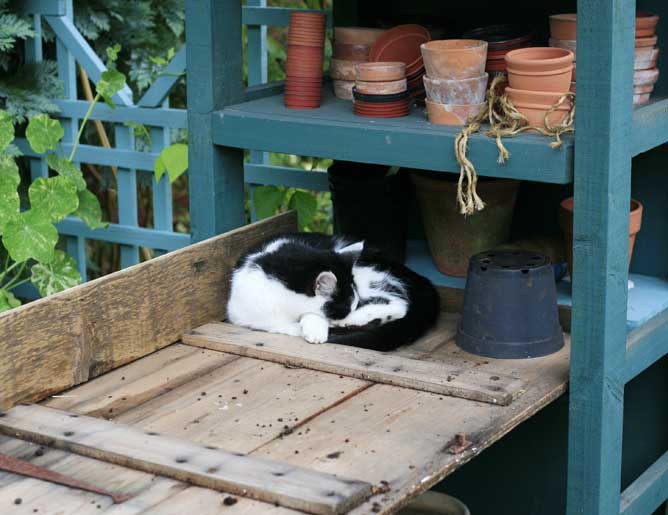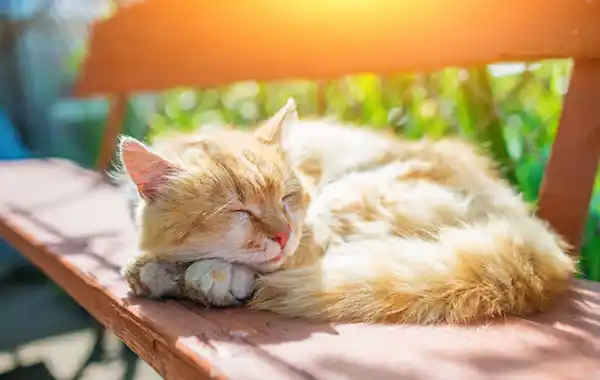Want to create the perfect cat-friendly garden for your cat to enjoy? Here's how you can meet your cats' needs to create the perfect garden paradise.
Garden expert Graham Strong shows you how to create the perfect garden paradise.

Now is the perfect time to get out in the garden, preparing for the warmer months ahead. But have you thought about designing your garden around your cat? It might not be quite what you had in mind but it can result in a happier puss, which makes for happier owners and even happier neighbours!
Being free-roaming creatures, you can take a cat out of the outdoors but you can't always take the outdoors out of the cat - scaling fences, pouncing from bushes and creeping through the undergrowth all come naturally. So why not nurture their need for exploration by creating a cat-friendly garden? Not only will this make your outdoor puss less likely to venture onto a nearby road in search of new adventures, but it might stop him squatting in the neighbours' gardens too!
Cat-friendly gardens
Like most wildlife (and our two cats are pretty wild at times!), cats much prefer a garden that is a bit rough at the edges to one that is maintained in immaculate order. Manicured lawns and narrow borders filled with the sort of dumpy summer bedding plants you see in your local park can quickly become a desert for wildlife and offer little opportunity for a cat to show off their natural instincts. Here are some cat-friendly garden ideas to get you thinking...
Top ten plants for cat lovers' gardens

Above from left: catnip, cat grass, runner beans, Michaelmas daisies, and squash.
- Catnip (Nepeta cataria) - Even more potent than catmint, this is the one they use to stuff kitty pillows and toys. Not as attractive as catmint, but easily raised from seed and will produce self-sown seedlings once established.
- Cat grass (Avena sativa) - There are several grasses that cats can snack on, but this is the most widely available as seed or, increasingly, sprouting in pots.
- Runner beans - What a treat the first tender beans of the summer are. Easy to grow and highly ornamental, set them out on a wigwam of canes or bean poles in early June to give your cat a secret hideaway and a shady spot to snooze.
- Michaelmas daisies - These wonderful late summer and autumn daisies stand out when others are flagging. Aster x frikartii is the one to look out for as it is a gem and free from mildew. Smothered in bees and butterflies, they are tall enough to form dense cover below for hunting expeditions.
- Pumpkins and squash - Choose trailing varieties (this is the delectable squash 'Potimarron') and plant them through a woven membrane like 'Plantex' to prevent weed growth. Your cat will have a whale of a time playing hide and seek.

Above from left: geraniums, caryopteris, sunflowers, tall ornamental grasses, and eucalyptus niphophila.
- Caryopteris - Not as widely known and grown as it should be, this is another late summer, blue- flowered shrub, highly attractive to insects and perfect for that hot spot under a wall or fence. It provides privacy and shelter for a shy cat.
- Sunflowers - Spring is the perfect time to sow them, either directly where they are to flower, or started off indoors in small pots. Choose from 12-foot monsters to shoulder-high blooms and under plant with Cosmos to thicken up the 'jungle'.
- Tall ornamental grasses - Choose a mixture of any of the tall varieties of Miscanthus grass and you'll soon have something resembling a sugar cane plantation. Elegant, atmospheric and the perfect stalking ground for a cat on the prowl.
- Eucalyptus niphophila - With handsome, scented, grey evergreen leaves, a patchwork bark, and unlikely to exceed bungalow height, this is a great choice to add character and, of course, a kitty climbing frame.
Plants that can be poisonous to cats

Above left: With the Century Plant (Agave), it is the needle-tipped leaves that cause injury. Right: the pollen from lilies can be deadly to cats if they lick it off their fur.
The following plants are most likely to cause injury if grown in an enclosed space, like an outdoor run, where cats may ingest them out of idle curiosity. Some are common garden plants, some are wild flowers, while others may pop up as self-sown seedlings distributed by the wind or bird droppings. Plants like Rue (Ruta) can be a serious skin irritant. For a more comprehensive list, including houseplants, visit International Cat Care's website.
- Aconitum
- Alstroemeria
- Brugmansia
- Colchicum
- Conium
- Daffodil
- Daphne
- Euphorbia
- Foxglove
- Helleborus
- Hemlock
- Henbane
- Laburnum
- Lily
- Lily of the Valley
- Morning Glory
- Oleander
- Nightshade, woody and deadly
- Poppy
- Potato
- Rhododendron
- Ruta
- Ricinus
- Tomato
- Yew.
Consider creating a cat safe haven with cat fencing solutions
- Cat enclosures are ideal for large rural gardens, freestanding cat runs are used infront of trees, shrubs and hedges, to keep cats safe within the expanses of your garden. Click here to see ProtectaPet's range of outdoor Cat Enclosures.
- Cat Fence Toppers - A quick and easy way to transform your garden into a cat safe haven so they have an outdoor territory without wandering further afield and encountering hazzards.
- Cat Pens and Catios - Extend your home onto your patio with the addition of a cat patio, or 'catio', for high security outdoor access for your cat.
Make a lookout post for your cat

I'd like to think it was the pleasure of my company, but I suspect it is more to do with feeling secure and getting an elevated viewpoint that makes the potting bench a favourite perching point for the cats. The pot store has a roof over it, so it is also dry.
Walk on the wild side

This garden is beautifully designed and as appealing to cats as it is to us. An upper storey of tree canopies offers dappled shade for a jungle layer of dense vegetation, studded with upturned tree stumps that make great lookout posts. A timber boardwalk allows for a quick sprint and offers a warm spot to soak up the sun.
Plant some low hedges

These impressive hedges are a feature of the imaginative garden at The Bannut in Herefordshire. Clipped from heather, they would make a wonderful maze for cats to stalk and pounce in and best of all, there is a cat-friendly millstone fountain at the centre.
Help stop your cat roaming by devoting more time to your own garden and making it more cat-friendly
A keen gardener's plot, like it or not, has great appeal for a cat who will enjoy having lots of plants to sniff, shelter within shrubs to hide and observe, insects to chase, and dug-over flowerbeds or vegetable patches to use.
You could do your cat a favour and emulate your 'greenfingered' neighbours - but as well as the pretty plants and flowers, you might choose to enhance your flowerbeds or containers and look at leaving a wild/untidy area that your cat could call his own.

What your cat and your neighbour will appreciate more than anything is the provision of an outdoor latrine. At its simplest, it could be a secluded square of earth that you've raked and that's easy for your cat to dig over and do his business. Provide some screening, but arrange it in such a way that the cat has a view out of and cannot be ambushed by another cat. Regularly use a trowel to dig over and remove faeces (into a nappy sack or doggy poo bag and then into a dustbin).
There's a lot to be said for providing your cat with a litter tray in the house. Given the option, many cats do actually prefer to use a tray. It means that you can be sure that he's not going to get into trouble - and you can be aware of any health issues straight away. Modern cat litters are good at masking smells and can be much easier to handle too - some can even be added to a compost heap.










